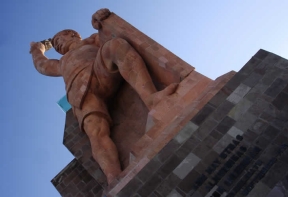Did El Pípila exist? Legend, history, name and biography : Independence of Mexico
News Category: News, Community News, and People of SMA
-
Published September 14th, 2021
Since we were children we learned in school the story of El Pípila, a brave character who during the Independence struggle accepted to risk his life by carrying a slab on his back to set fire to the door of the Alhóndiga de Granaditas.
But, did El Pípila really exist? Who was this emblematic character in Guanajuato? What is his real name?
The first information we have about El Pípila was written by historian and chronicler José María de Bustamante, author of several texts on the history of the Independence struggle.
These articles were initially published in the press, but between 1844 and 1846, they were compiled in three volumes under the name of Cuadro Histórico de la Revolución.
It is precisely in these texts that Bustamante narrates the story of the Pípila.
“Surrounded by a whirlwind of plebs, [Miguel Hidalgo] directed his voice to a man who ran it and told him: Pípila! … The homeland needs your courage… Will you dare to set fire to the door of the Alhóndiga? The undertaking was very risky, since he needed to put his body in the open to a hail of bullets; Pípila without hesitation said yes. He took one of the many wide slabs in Guanajuato; he put it on his head […] and almost on all fours he marched to the door of the Alhóndiga, mocking the enemy bullets”.
The figure of Pípila and his feat aroused great popular support, the people immediately identified with the miner who risked his life for the cause of Independence, to such a degree that with the passage of time it became consolidated as the official version of history.
The man behind the legend
It is said that El Pípila was born in San Miguel de Allende; his real name was Juan José de los Reyes Martínez.
There are two versions of why Juan José earned the nickname Pípila. In the Bajío, pípila is the word used to designate turkeys, it is said that Reyes Martínez received this nickname because of the freckles he had that gave him a dotted appearance similar to the plumage of this poultry; another version points out that his laugh resembled a squawk.
At the time of the fight for independence, Reyes Martínez was a sweeper in the mining town of Mellado, a job he left to join the ranks of the insurgent army led by the priest Miguel Hidalgo.
The insurgents tried to take the Alhóndiga de Granaditas, but their attempts failed. It was when the priest Hidalgo pointed out that the main door had to be burned and asked for the help of Pípila.
The humble barretero accepted the assignment. He took a slab to protect himself from the bullets and a torch to set fire to the door of the Alhóndiga.
Finally, El Pípila fulfilled his mission; the Alhóndiga de Granaditas was taken and the Spaniards taking refuge inside were massacred.
El Pípila continued as a fighter for the independence cause; it is said that he died in 1863, in his native San Miguel de Allende.
A myth of Independence?
Lucas Alamán, an influential historian on the side of the conservatives in the 19th century, refuted Bustamante’s version of El Pípila and assured that this character was an invention without real support.
-


Leave a Reply